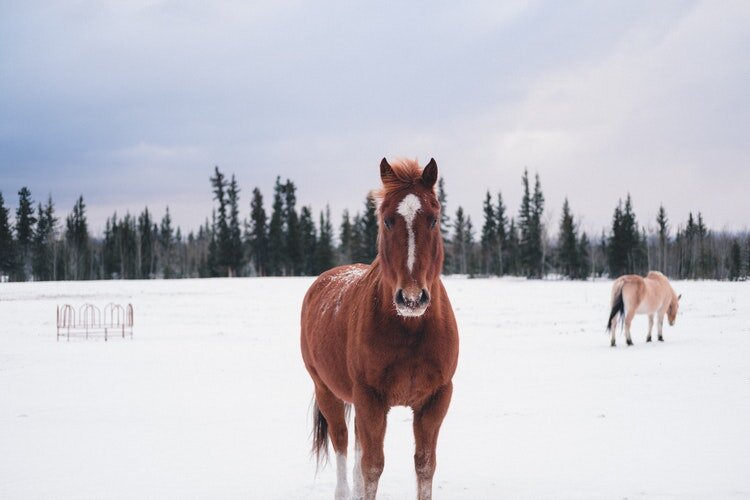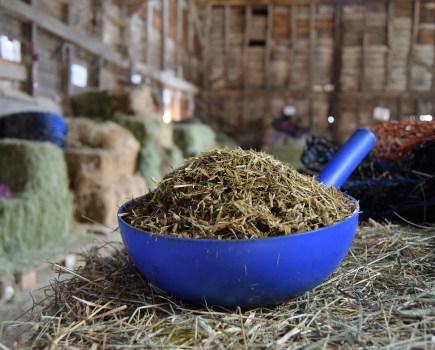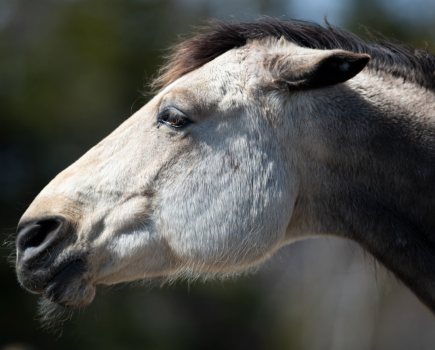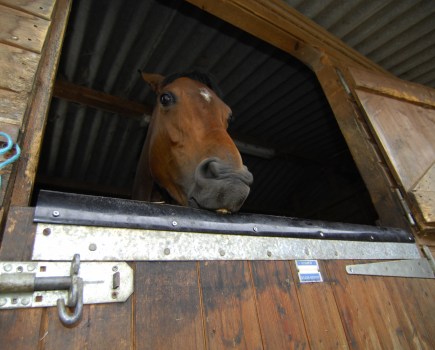Just because we feel the cold doesn’t mean that our horses do. When temperatures go below 0°C, horses who aren’t rugged will require more food to keep warm because they’ll start to use more energy, but they still don’t necessarily need to wear a rug. One of the major sources of heat for horses is the fermentation of fibre and forage — a bit like the old Readybrek advert for kids, forage is central heating for horses. Most horses will cope well without rugs as long as they have ad-lib forage available.
Some horses will benefit from being rugged though, such as horses who have been clipped. Clipping a horse who’s in work makes life easier because it means they will dry quicker after they’ve sweated during exercise. Similarly, horses that have a low body condition score, are ill or recovering from injury or illness, have respiratory, heart or lung disease or chronic illness, as well as older horses and very young horses, should all be rugged when the temperature drops.
The parallels are similar in humans — older people, very young children and babies, and people with chronic illnesses need help staying warm. Just as with horses though, there are individual variations: some people walk around in t-shirts and shorts while others are wearing woolly jumpers. Breed and type play a part too. A Shetland pony with a thick coat is less likely to need a rug than a fine-coated Thoroughbred, for example.
The weather can also have a big impact on whether to rug a horse or not. When you have a combination of rain, wind and cold, horses may benefit from a lightweight, waterproof sheet because they lose considerably more heat if they’re wet. If it’s 10°C and dry, that’s very different to 10°C and wet and windy. The availability of shelter is an important consideration too. If a horse has ample shelter so they can get out of the wind and rain, they’re less likely to need a rug.
What is thermoregulation?
Horses and humans have different reactions to the cold and we need to keep this in mind when rugging. The horse has the same mechanism for keeping warm or cooling down that humans have. When we get too hot, the blood vessels in our skin start to open up and that increases the amount of heat that is lost at the surface. As we get colder, those blood vessels narrow and less blood goes to the skin.
In many ways, thermoregulation in both horse and human is the same. When we get too hot, we start to sweat or we may increase our breathing rate — we see that in horses and in people. When we get too cold, we reduce our blood flow to the surface even more and may start to shiver — and it’s much the same for horses.
What is a horse’s ‘thermoneutral zone’?
A person’s temperature alters constantly, and it’s the same with horses. This fluctuation is how we keep our temperature within our ‘thermoneutral zone’. This is the range of temperatures within which you’re not obviously trying to keep yourself warm or cool yourself down, so you’re not shivering or sweating. Within both the human and horse thermoneutral zone, body temperature is controlled through the blood flow to the skin.
The differences are the extent to which these are used and the capacity for cooling and heating. One key difference is the size of a human compared to a horse. Large animals are good at keeping heat in and small ones are better at losing heat. In cold weather, a big horse, for example, will feel much more comfortable than a small bird. That’s why many birds migrate in winter.
The horse is interesting and different in that it can survive in climates from minus 40°C to plus 40°C. The horse is very well adapted, even though it’s a large animal. Technically, horses should be better off in cold temperatures because of their size, but they do well in the heat because they have an incredible capacity to sweat.
No other animal can sweat more than a horse. If we compare the rates of sweating through the same amount of skin, a cm² of horse skin can sweat three to four times as much as cm² of human skin. So providing that sweat can evaporate, horses have three to four times the capacity to cool themselves through sweating than we do, even though they are five to six times bigger.
When do horses feel cold?
For humans, our thermoneutral zone (when we don’t have any clothes on) is between 25°C and 30°C. Without clothing, once it gets below 25°C, we feel cold. A horse with a natural coat has a thermoneutral zone of between 5°C and 25°C. What this means is that the horse is able to tolerate a much greater range of temperatures before they need to do anything to keep themselves warm. A horse generally doesn’t start to feel cold until it’s 5°C or lower.
As autumn comes and we reach for our fleeces at around 10-15°C, our horse doesn’t perceive that temperature drop in the same way, so we’re not doing our horse any favours by piling on the rugs. They simply don’t need them, as they’re already wearing the equivalent of a four-tog duvet. Of course, if your horse is fully clipped, then they will start to feel the cold sooner, just as we would.
We tend to over-rug because we think that since we’re starting to feel cold, our horses must be too, but that’s a big misconception.
Dr David Marlin’s members area on his website provides access to science-backed information spanning a wide range of horse-related matters, including webinars, latest research findings, independent product trials and celebrity interviews, with the additional opportunity to join a friendly, supportive private community of fellow horse lovers. Pay-monthly membership is £8. Find out more and join here.
When does a horse need to wear a rug?
Healthy cob/native
A cob or native breed who is overweight but otherwise healthy, and has a full coat, doesn’t need a rug until temperatures reach 0°C overnight — or until it gets very wet and windy and the horse is living out with no shelter. Otherwise, ad-lib forage and shelter are adequate.
Veteran/poorly horse
An older or recovering horse with any of the following would benefit from being rugged sooner rather than later:
- Low body condition score
- Need to gain weight
- Has a reduced appetite
- Isn’t eating huge amounts of forage
- Has some issues with teeth
- Has a predisposition to colic
- Has other health issues such as compromised liver function
Rug overnight with a medium-weight rug and possibly rug them during the day too. If they live out, ad-lib forage and shelter are vital.
Poor doers
Hot-blooded horses such as Thoroughbreds often feel the cold more than a warm- or cold-blooded horse, and will require rugging to maintain their weight, especially if they are prone to losing condition in the colder months. A horse who loses weight through the winter would likely need a heavier rug to give a higher level of protection.
Clipped horse in work
A fit horse who’s clipped and in work will need rugging to replace the protection their natural coat would give them. Even if they’re stabled at night, they’ll require at least a mediumweight rug with a neck cover to prevent too much heat loss.









